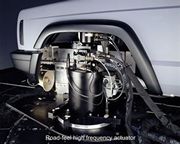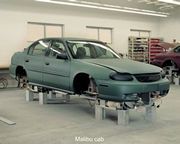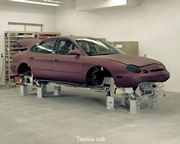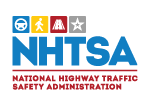NADS Subsystem Module Description
The NADS contains several subsystems which provide the driver with a direct presentation of the driving environment. These subsystems work in real time to provide a repeatable, natural and undistorted representation of the visual, motion, auditory and control feel sensory cues associated with the complete driving environment.
- Visual System - The Visual System provides the driver a realistic fields of view, including the rear view mirror images. The driving scene has three dimensional perspective and is fully correlated with all of the other sensory stimulus. The Visual System database includes the full range of current and new highway traffic control devices (signs, signals and delineation), three dimensional objects that vehicles encounter (animals, potholes, concrete joints, pillars, etc.), high density, multiple lane traffic interacting with driver's vehicle, common intersection types (including railroad crossings, overpasses, bridge structures, tunnels, etc.) and roadway time of day and weather environment.
- Motion System - The Motion System provides a combination of translational and angular motion that duplicates vehicle motion kinematics and dynamics within six degrees of freedom. The Motion System is coordinated with the Vehicle Cab System and its High Frequency Road Feel and Control Feel System to provide the driver with realistic motion and haptic cuing during normal driving and pre-crash scenarios. The motion system is configured and sized to correctly represent the specific forces and angular rates associated with actual vehicle motions for the full range of driving maneuvers.


- Vehicle Cab System -
The Vehicle Cab System consists of four actual vehicle cabs, configured to fit within the physical environment of the visual dome on the motion system and provides the driver with a realistic vehicle driving experiences. The cabs have defined interfaces and allow rapid interchangeability in order to meet the desired efficiency standards during NADS operations. The cabs have a full range of standard, optional and new design vehicle instrumentation interfaces. The cabs can be reconfigured to accommodate new technology when it becomes available.


- Control Feel System - The Control Feel Systems for steering, brakes, clutch, transmission shift and throttle provide realistic control of feel feedback in response to driver inputs, vehicle motions and road/tire interactions over the vehicle maneuvering and operating ranges. The control feel systems is capable of representing automatic and manual control characteristics such as power steering, existing and experimental drive trains, Anti-lock Braking Systems and cruise control. The control feel cuing feedback has high bandwidth and no discernible delay or distortion associated with driver control actions or vehicle dynamics.
- Auditory System - The Auditory System provides motion-correlated, directional sound sources. These sound sources are coordinated with the full range of the visual sensory systems database. The auditory database includes sounds emanating from current and new design highway surfaces, from contact with three dimensional objects that vehicles encounter (potholes, concrete/tar joints, pillars, etc.), from high density, multiple lane traffic, from the vehicle during operation and sounds which reflect roadway changes due to changes in the weather environments.
- Vehicle Dynamics - The Vehicle Dynamics software properly represent vehicle motions and control feel conditions in response to driver control actions, road surface friction conditions and aerodynamic disturbances. All required vehicle responses are computed in real time for commanding the Visual, Motion, Cab, Control Feel and Auditory Systems. The vehicle dynamics models cover light passenger cars and trucks, and heavy trucks and buses. The models will encompass normal driving conditions and limit performance maneuvering that might be encountered during precrash avoidance situations, including spinout and incipient rollover.
